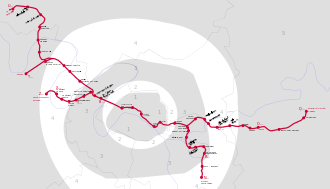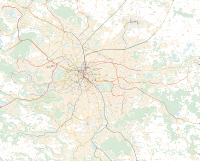RER A
RER A is one of the five lines in the Réseau Express Régional (English: Regional Express Network), a hybrid suburban commuter and rapid transit system serving Paris, France and its suburbs. The 108.5 km (67.4 mi) RER A line crosses the Paris region from east to west, with all trains serving a group of stations in central Paris, before branching out towards the ends of the line.
| RER A | |||
|---|---|---|---|
 | |||
| Overview | |||
| Type | Rapid transit/commuter rail | ||
| System | Réseau Express Régional | ||
| Status | Operational | ||
| Termini | Saint-Germain-en-Laye (A1), Cergy-le-Haut (A3), Poissy (A5) Boissy-Saint-Léger (A2), Marne-la-Vallée–Chessy (A4) | ||
| Stations | 46 | ||
| Ridership | 300,000,000 journeys per year | ||
| Operation | |||
| Opened | 8 December 1977 (last extension in 1994) | ||
| Operator(s) | RATP/SNCF | ||
| Rolling stock | MI 2N, MI 09 | ||
| Technical | |||
| Line length | 108.5 km (67.4 mi) | ||
| Track gauge | 1,435 mm (4 ft 8 1⁄2 in) standard gauge | ||
| |||
The initial portion of the line was built in stages between December 1969 and December 1977 by connecting two existing suburban commuter rail lines with a new tunnel under Paris: the line between Vincennes and Boissy-Saint-Léger in the east (which formerly terminated at the now-closed Gare de la Bastille), and the line between Saint-Germain-en-Laye and Nanterre line in the west (which formerly used a surface alignment to Paris Saint-Lazare which is still in use as Transilien L). The viaduct between Vincennes and the former Gare de la Bastille terminus was redeveloped into the Promenade plantée elevated park in 1993.[1]
Since opening, three additional branches have been added: one in the east serving Marne-la-Vallée and Disneyland Paris and two to the west serving Poissy and Cergy.
The RER A has had a significant social impact on Paris and the surrounding region by speeding up trips across central Paris, by making far fewer stops than the Paris Métro and by bringing far-flung suburbs within easy reach of the city centre. The line has far exceeded all traffic expectations, currently serving over 1.2 million passengers per day, on about 300 million journeys per year. That makes the RER A the busiest single rail line outside of East Asia.
RER A | |||||||||||||||||||||||||||||||||||||||||||||||||||||||||||||||||||||||||||||||||||||||||||||||||||||||||||||||||||||||||||||||||||||||||||||||||||||||||||||||||||||||||||||||||||||||||||||||||||||||||||||||||||||||||||||||||||||||||||||||||||||||||||||||||||||||||||||||||
|---|---|---|---|---|---|---|---|---|---|---|---|---|---|---|---|---|---|---|---|---|---|---|---|---|---|---|---|---|---|---|---|---|---|---|---|---|---|---|---|---|---|---|---|---|---|---|---|---|---|---|---|---|---|---|---|---|---|---|---|---|---|---|---|---|---|---|---|---|---|---|---|---|---|---|---|---|---|---|---|---|---|---|---|---|---|---|---|---|---|---|---|---|---|---|---|---|---|---|---|---|---|---|---|---|---|---|---|---|---|---|---|---|---|---|---|---|---|---|---|---|---|---|---|---|---|---|---|---|---|---|---|---|---|---|---|---|---|---|---|---|---|---|---|---|---|---|---|---|---|---|---|---|---|---|---|---|---|---|---|---|---|---|---|---|---|---|---|---|---|---|---|---|---|---|---|---|---|---|---|---|---|---|---|---|---|---|---|---|---|---|---|---|---|---|---|---|---|---|---|---|---|---|---|---|---|---|---|---|---|---|---|---|---|---|---|---|---|---|---|---|---|---|---|---|---|---|---|---|---|---|---|---|---|---|---|---|---|---|---|---|---|---|---|---|---|---|---|---|---|---|---|---|---|---|---|---|---|---|---|---|---|---|---|---|---|---|---|---|---|---|---|---|---|
| |||||||||||||||||||||||||||||||||||||||||||||||||||||||||||||||||||||||||||||||||||||||||||||||||||||||||||||||||||||||||||||||||||||||||||||||||||||||||||||||||||||||||||||||||||||||||||||||||||||||||||||||||||||||||||||||||||||||||||||||||||||||||||||||||||||||||||||||||
Popular success and responses
The line has far exceeded all traffic expectations, currently serving over 1.2 million passengers per day, on about 300 million journeys per year.[2][3] That makes the RER A the busiest single rail line outside of East Asia.[4] Ever-increasing traffic volume and the need to ward off imminent saturation have been major factors in RATP and SNCF's planning since the inauguration of the line.
Several major capital investments have been made to relive overcrowding on the line:
- The line's traditional signalling block system, which allowed only one train to occupy a "block" of track, was replaced in September 1989 with a dynamic traffic control system. The Système d'aide à la conduite, à l'exploitation et à la maintenance or SACEM (English: Driver Assistance, Operation, and Maintenance System) enables extremely short spacing between trains, increasing capacity on the line. The SACEM system is scheduled to be replaced in the mid- to late-2020s with an even more advanced communications-based train control system.
- Paris Métro Line 14, which opened 15 October 1998, was built on a route that would relieve congestion on the segment of RER A that passes through central Paris.
- RER E, which opened 14 July 1999, was built on a route that would also serve the eastern suburbs of Paris and an 8 km (5.0 mi) tunnel is being built under central Paris that will connect the RER E to La Défense. Once the tunnel is complete, the RER A's A5 branch to Poissy will be served by the RER E. The project is expected to reduce the load on the central section of the RER A by 10-15%
- Double-deck trains (MI 2N series) entered service in 1998 to increase the passenger carrying capacity on each run of the RER A. The 43 double-deck trains can carry up to 2,600 people per train, compared to 1,887 people on the older single-deck MS 61 trains. The double-deck trains proved so successful and popular, that RATP placed an order for 140 MI 09 double-deck trains that entered service in 2011, and has replaced all the remaining single-deck trains on the RER A.[5]
Chronology
_par_Cramos.jpg)
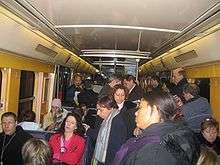
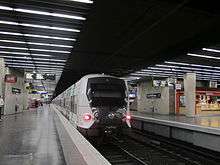
- 6 July 1961: First planning begins for tunnel under Paris to connect Étoile to the new La Défense business district. These plans would go on to become the much more ambitious RER A.
- 14 December 1969: The first Regional Metro segment begins service after RATP purchases the Ligne de Vincennes between Bastille and Boissy-Saint-Léger from SNCF and connects it to a new 2.5 km (1.6 mi) tunnel under Paris between Vincennes and Nation, which replaces Bastille as the terminus. This creates a 17.5 km (10.9 mi) eastern line between Nation and Boissy-Saint-Léger.
- 19 January 1970: 4 km (2.5 mi) tunnel opens between Étoile and La Défense. Since this tunnel is isolated from the other section, it is operated as a navette (shuttle) service.
- 23 November 1971: Tunnel extended 2 km (1.2 mi) east to Auber. Shuttle service extended to operate between La Défense and Auber.
- 1 October 1972: The second Regional Metro segment opens as RATP purchases the Ligne de Saint-Germain between Nanterre-Université and Saint-Germain-en-Laye from SNCF and connects it to a new 2 km (1.2 mi) tunnel to La Défense. This creates a 13 km (8.1 mi) western line between Saint-Germain-en-Laye and Auber.
- 1 October 1973: New infill underground Nanterre–Préfecture station opens.
- 8 December 1977: The Regional Metro becomes RER A as the final 6 km (3.7 mi) segment under Paris is completed, adding two new underground stations: Gare de Lyon and Châtelet–Les Halles. A portion of this new tunnel is shared with the Ligne de Sceaux which becomes RER B. The newly linked segments create a 42.5 km (26.4 mi) line between Saint-Germain-en-Laye and Boissy-Saint-Léger. At the same time, the first segment of the Ligne nouvelle de Marne-la-Vallée (English: New line of Marne-la-Vallée) opens. This new 8.5 km (5.3 mi) branch extends the line east to Noisy-le-Grand-Mont d’Est.
- 19 December 1980: The Ligne nouvelle de Marne-la-Vallée extended 9 km (5.6 mi) to Torcy.
- 29 May 1988: "Interconnexion Ouest" (English: West Interconnection) branch added, extending trains 15.5 km (9.6 mi) northwest on SNCF tracks from Nanterre-Préfecture to Cergy-Saint-Christophe.
- 29 May 1989: 8.5 km (5.3 mi) branch added off the "Interconnexion Ouest" connecting Maisons-Laffitte and Poissy.
- 1 April 1992: The Ligne nouvelle de Marne-la-Vallée completed with 11 km (6.8 mi) extension to Marne-la-Vallée–Chessy, creating a link to Disneyland Paris, which would open on 12 April 1992.
- 29 August 1994: Line extended 2.5 km (1.6 mi) west to Cergy-le-Haut, new Neuville-Université station opens.
- 10 June 2001: New Val d'Europe station opens.
List of RER A stations
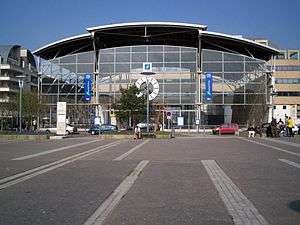
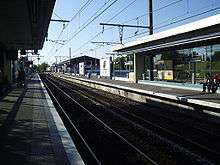
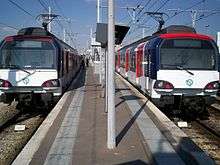
- A1
- Saint-Germain-en-Laye
- Le Vésinet – Le Pecq
- Le Vésinet – Centre
- Chatou – Croissy
- Rueil-Malmaison
- Nanterre – Ville
- Nanterre – Université
- A3, A5
- A3
- Cergy-le-Haut
- Cergy – Saint-Christophe
- Cergy – Préfecture
- Neuville – Université
- Conflans – Fin d'Oise
- Achères – Ville
- A5
- Poissy
- Achères – Grand Cormier
- Maisons-Laffitte
- Sartrouville
- Houilles–Carrières-sur-Seine
- A3
- Nanterre-Préfecture
- La Défense
- Charles de Gaulle–Étoile
- Gare d'Auber
- Châtelet–Les Halles
- Gare de Lyon
- Nation
- Gare de Vincennes
- A2
- Fontenay-sous-Bois
- Nogent-sur-Marne
- Joinville-le-Pont
- Saint-Maur – Créteil
- Le Parc de Saint-Maur
- Champigny
- La Varenne – Chennevières
- Sucy – Bonneuil
- Boissy-Saint-Léger
- A4
- Val de Fontenay
- Neuilly-Plaisance
- Bry-sur-Marne
- Noisy-le-Grand – Mont d'Est
- Noisy – Champs
- Noisiel
- Lognes
- Torcy
- Bussy-Saint-Georges
- Val d'Europe
- Marne-la-Vallée – Chessy
Operation
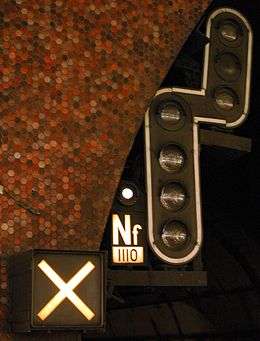
Branches
Line A provides two groups of services:
- St Germain branch – common trunk line – Boissy branch
- Cergy or Poissy branches – common trunk line – Marne la Vallée branch.
During off-peak hours, the Poissy – Noisy services operate every 20 minutes plus a La Défense – Noisy service every 20 minutes, and the St-Germain – Boissy and Cergy – Chessy services operate every 10 minutes.
Operations are very complex during peak periods, with an average of one train every 2 minutes (30 trains / hour) on the common trunk line in the busier direction (east to west in the morning, west to east in the evening), and one train every 2 min 30 sec in the other direction (24 trains / hour). The Marne la Vallée branch has the most intensive service.
Names of services
RER trains display a "nom de mission" or "name of service", not the name of the destination station. These are invented names designating (and distinguishing) individual services ("runs"), and are accompanied by a two-digit number, for example ZARA59 or DJIB72.
The first letter corresponds to the destination (gare d'arrivée):
| Letter | To | Examples of names of services |
|---|---|---|
| B | La Défense | BYLL, BORA, BTON |
| D | Noisy-le-Grand – Mont d'Est | DYNO, DJIN, DOMI |
| N | Boissy-St-Léger | NELY, NAGA |
| O | Torcy | OKEY, ORKA, OFRE |
| Q | Marne-la-Vallée – Chessy | QUDO, QIKY, QBIK, QAHA |
| R | La Varenne-Chennevières | RHIN, RUDI |
| T | Poissy | TERI, TJAC, TIKY |
| U | Cergy-le-Haut | UPAL, UDON, UXOL |
| W | (empty train) | WQWZ |
| X | Le Vésinet – Le Pecq | XUTI, XOUD |
| Y | Rueil-Malmaison | YCAR, YVAN |
| Z | Saint-Germain-en-Laye | ZARA, ZEUS, ZINC |
The second letter corresponds to the stations served and the origin station: a letter can have different meanings, depending on the destination. For instance, second letter "E" indicates:
- with first letter "N" or "Z", all stations Saint-Germain-in-Laye – Boissy-St-Léger (NELY or ZEUS);
- with first letter "Q", Poissy to Marne-la-Vallée – Chessy, all stations except Neuilly-Plaisance and Bry-sur-Marne (QENO).
The third and fourth letters are used to form a pronounceable name, changed when the service number (odd 01-99 eastward, even 02-98 westward) reaches the maximum. For example, successive trains to Boissy-St-Léger are called NEGE96, NEGE98, then NELY02, NELY04, etc. Each service is uniquely identifiable, as there cannot be two "NEGE" services with the same number in the same day.
Services with the same first two letters serve the same stations, e.g. ZEBU, ZEUS and ZEMA (to Saint-Germain-en-Laye), or NEGE, NELY and NEMO (to Boissy-Saint-Léger). The letters ZZ generally indicate that the established service pattern was changed for an unspecified reason, generally a technical problem which disrupted operations.
Morning Peak
Every 10 minutes:
- Boissy – Le Vésinet-Le Pecq, all stations except Nanterre-Ville.
- La Varenne – St-Germain, all stations except Chatou-Croissy and Le Vésinet-Centre.
- Marne-la-Vallée – Chessy – Cergy-le-Haut, all stations except Lognes, Noisiel, Bry-sur-Marne, Houilles and Maisons-Laffitte.
- Marne-la-Vallée – Chessy – Poissy, all stations except Val d'Europe, Bussy-St-Georges, Lognes, Noisy-Champs and Sartrouville.
- Torcy – Rueil-Malmaison, all stations except Bry, Neuilly-Plaisance and Nanterre-Préfecture.
- Cergy – Torcy, all stations except Maisons-Laffitte, Houilles, Noisiel and Lognes.
- Poissy – Chessy, all stations except Neuilly-Plaisance and Bry.
- St-Germain – Boissy, all stations except Le Vésinet-Centre and Chatou-Croissy.
- Le Vésinet-Le Pecq – La Varenne, all stations except Nanterre-Préfecture, Vincennes and Fontenay.
Evening Peak
Every 10 minutes:
- Cergy – Noisy-le-Grand, all stations except Maisons-Laffitte and Houilles.
- Poissy – Chessy, all stations except Sartrouville, Bry, Noisiel and Lognes.
- St-Germain – Boissy, all stations except Nanterre-Ville and Nanterre-Préfecture.
- Le Vésinet-Le Pecq – La Varenne, all stations except Vésinet-Centre and Chatou-Croissy.
- La Défense – Torcy, all stations except Neuilly-Plaisance and Bry.
- Chessy – Poissy, all stations except Bry and Neuilly-Plaisance.
- Boissy – Le Vésinet-Le Pecq, all stations.
- Noisy – Cergy-le-Haut, all stations except Houilles and Maisons-Laffitte.
- La Varenne – St-Germain, all stations except Fontenay, Vincennes, Nanterre-Préfecture, Chatou-Croissy and Le Vésinet-Centre.
Off Peak
In both directions every 10 minutes:
- St-Germain-en-Laye – Boissy-St-Léger.
- Cergy-le-Haut – Marne la Vallée-Chessy.
In both directions every 20 minutes:
- Poissy – Noisy-le-Grand – Mont d'Est.
- La Défense – Noisy-le-Grand – Mont d'Est.
Off-peak, a train is scheduled every 3 minutes 20 seconds between La Défense and Vincennes in both directions.
See also
- List of stations of the Paris Métro
- List of stations of the Paris RER
References
- Campbell, Robert (12 March 2002). "Viaduc des Arts and Promenade Plantée: A Paris match?". Boston.com. Retrieved 24 October 2014.
- (in French) LCI.fr: RER A – "10 secondes de retard, 15.000 voyageurs affectés !" Archived 12 October 2009 at the Wayback Machine
- RATP. "Schéma directeur du RER A" (PDF) (in French). Archived from the original (PDF) on 1 March 2013. Retrieved 4 July 2012.
- Gerondeau, Christian (2003). La Saga du RER et le maillon manquant. Presse de l'École nationale des ponts et chaussées. ISBN 2-85978-368-7.
- "MI 09 tout neuf" [MI 09 Brand New] (in French). France: MetroPole. 5 December 2011. Archived from the original on 16 January 2012.
External links

